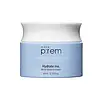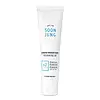What's inside
What's inside
 Key Ingredients
Key Ingredients

 Benefits
Benefits

 Concerns
Concerns

 Ingredients Side-by-side
Ingredients Side-by-side

Water
Skin ConditioningGlycerin
HumectantCyclopentasiloxane
Emollient1,2-Hexanediol
Skin ConditioningCaprylic/Capric Triglyceride
MaskingCetyl Ethylhexanoate
EmollientCyclomethicone
EmollientDimethicone
EmollientGlycereth-26
HumectantMacadamia Integrifolia Seed Oil
Skin ConditioningBrassica Campestris Sterols
EmollientCholesterol
EmollientPEG-5 Rapeseed Sterol
CleansingCyclohexasiloxane
EmollientRubus Arcticus Fruit Extract
AntioxidantOlea Europaea Fruit Oil
MaskingAspalathus Linearis Leaf Extract
Skin ConditioningFoeniculum Vulgare Leaf Extract
HumectantThymus Vulgaris Extract
PerfumingLavandula Angustifolia Oil
MaskingRose Flower Oil
MaskingThermus Thermophillus Ferment
Skin ConditioningRosmarinus Officinalis Leaf Oil
MaskingTheobroma Cacao Extract
Skin ConditioningMelaleuca Alternifolia Leaf Oil
AntioxidantPelargonium Graveolens Flower Oil
MaskingAscophyllum Nodosum Extract
Skin ConditioningLeuconostoc/Radish Root Ferment Filtrate
AntimicrobialHydrogenated Polydecene
EmollientPentylene Glycol
Skin ConditioningCeteth-3
EmulsifyingCeteth-5
EmulsifyingPEG-240/Hdi Copolymer Bis-Decyltetradeceth-20 Ether
StabilisingAmmonium Acryloyldimethyltaurate/Vp Copolymer
Hydrogenated Lecithin
EmulsifyingSodium Hyaluronate
HumectantCaprylyl Glycol
EmollientSorbitan Stearate
EmulsifyingDimethiconol
EmollientGlyceryl Stearate
EmollientPEG-100 Stearate
Panthenol
Skin ConditioningPolyglutamic Acid
Skin ConditioningC12-20 Alkyl Glucoside
EmulsifyingCeramide NP
Skin ConditioningAcrylates/C10-30 Alkyl Acrylate Crosspolymer
Emulsion StabilisingEthylhexylglycerin
Skin ConditioningStearic Acid
CleansingTromethamine
BufferingOleic Acid
EmollientTocopheryl Acetate
AntioxidantDimethicone Crosspolymer
Emulsion StabilisingPolyglyceryl-10 Oleate
Skin ConditioningPropanediol
SolventButylene Glycol
HumectantLecithin
EmollientSodium Dilauramidoglutamide Lysine
HumectantLysolecithin
EmulsifyingPhytosterols
Skin ConditioningDextrin
AbsorbentSodium Ascorbyl Phosphate
AntioxidantDisodium Phosphate
BufferingSodium Phosphate
BufferingPotassium Laurate
EmulsifyingSaccharide Isomerate
HumectantGlyceryl Caprylate
EmollientHyaluronic Acid
HumectantCitric Acid
BufferingHydrolyzed Hyaluronic Acid
HumectantC14-22 Alcohols
Emulsion StabilisingCetearyl Alcohol
EmollientAlcohol
AntimicrobialXanthan Gum
EmulsifyingBHT
AntioxidantDisodium EDTA
Potassium Sorbate
PreservativeParfum
MaskingWater, Glycerin, Cyclopentasiloxane, 1,2-Hexanediol, Caprylic/Capric Triglyceride, Cetyl Ethylhexanoate, Cyclomethicone, Dimethicone, Glycereth-26, Macadamia Integrifolia Seed Oil, Brassica Campestris Sterols, Cholesterol, PEG-5 Rapeseed Sterol, Cyclohexasiloxane, Rubus Arcticus Fruit Extract, Olea Europaea Fruit Oil, Aspalathus Linearis Leaf Extract, Foeniculum Vulgare Leaf Extract, Thymus Vulgaris Extract, Lavandula Angustifolia Oil, Rose Flower Oil, Thermus Thermophillus Ferment, Rosmarinus Officinalis Leaf Oil, Theobroma Cacao Extract, Melaleuca Alternifolia Leaf Oil, Pelargonium Graveolens Flower Oil, Ascophyllum Nodosum Extract, Leuconostoc/Radish Root Ferment Filtrate, Hydrogenated Polydecene, Pentylene Glycol, Ceteth-3, Ceteth-5, PEG-240/Hdi Copolymer Bis-Decyltetradeceth-20 Ether, Ammonium Acryloyldimethyltaurate/Vp Copolymer, Hydrogenated Lecithin, Sodium Hyaluronate, Caprylyl Glycol, Sorbitan Stearate, Dimethiconol, Glyceryl Stearate, PEG-100 Stearate, Panthenol, Polyglutamic Acid, C12-20 Alkyl Glucoside, Ceramide NP, Acrylates/C10-30 Alkyl Acrylate Crosspolymer, Ethylhexylglycerin, Stearic Acid, Tromethamine, Oleic Acid, Tocopheryl Acetate, Dimethicone Crosspolymer, Polyglyceryl-10 Oleate, Propanediol, Butylene Glycol, Lecithin, Sodium Dilauramidoglutamide Lysine, Lysolecithin, Phytosterols, Dextrin, Sodium Ascorbyl Phosphate, Disodium Phosphate, Sodium Phosphate, Potassium Laurate, Saccharide Isomerate, Glyceryl Caprylate, Hyaluronic Acid, Citric Acid, Hydrolyzed Hyaluronic Acid, C14-22 Alcohols, Cetearyl Alcohol, Alcohol, Xanthan Gum, BHT, Disodium EDTA, Potassium Sorbate, Parfum
Water
Skin ConditioningPropanediol
SolventPentaerythrityl Tetraethylhexanoate
EmollientCaprylic/Capric Triglyceride
MaskingGlycerin
HumectantHelianthus Annuus Seed Oil
EmollientPolyglyceryl-3 Methylglucose Distearate
EmulsifyingButyrospermum Parkii Butter
Skin ConditioningCetearyl Alcohol
EmollientPanthenol
Skin ConditioningMadecassoside
AntioxidantCamellia Sinensis Leaf Extract
AntimicrobialCeramide AP
Skin Conditioning1,2-Hexanediol
Skin ConditioningPotassium Carbomer
Emulsion StabilisingXanthan Gum
EmulsifyingButylene Glycol
HumectantDisodium EDTA
Water, Propanediol, Pentaerythrityl Tetraethylhexanoate, Caprylic/Capric Triglyceride, Glycerin, Helianthus Annuus Seed Oil, Polyglyceryl-3 Methylglucose Distearate, Butyrospermum Parkii Butter, Cetearyl Alcohol, Panthenol, Madecassoside, Camellia Sinensis Leaf Extract, Ceramide AP, 1,2-Hexanediol, Potassium Carbomer, Xanthan Gum, Butylene Glycol, Disodium EDTA
 Reviews
Reviews

Alternatives
Ingredients Explained
These ingredients are found in both products.
Ingredients higher up in an ingredient list are typically present in a larger amount.
1,2-Hexanediol is a synthetic liquid and another multi-functional powerhouse.
It is a:
- Humectant, drawing moisture into the skin
- Emollient, helping to soften skin
- Solvent, dispersing and stabilizing formulas
- Preservative booster, enhancing the antimicrobial activity of other preservatives
Butylene Glycol (or BG) is used within cosmetic products for a few different reasons:
Overall, Butylene Glycol is a safe and well-rounded ingredient that works well with other ingredients.
Though this ingredient works well with most skin types, some people with sensitive skin may experience a reaction such as allergic rashes, closed comedones, or itchiness.
Learn more about Butylene GlycolThis ingredient is an emollient, solvent, and texture enhancer. It is considered a skin-softener by helping the skin prevent moisture loss.
It helps thicken a product's formula and makes it easier to spread by dissolving clumping compounds.
Caprylic Triglyceride is made by combining glycerin with coconut oil, forming a clear liquid.
While there is an assumption Caprylic Triglyceride can clog pores due to it being derived from coconut oil, there is no research supporting this.
Learn more about Caprylic/Capric TriglycerideCetearyl alcohol is a mixture of two fatty alcohols: cetyl alcohol and stearyl alcohol. It is mainly used as an emulsifier. Emulsifiers help prevent the separation of oils and products. Due to its composition, it can also be used to thicken a product or help create foam.
Cetearyl alcohol is an emollient. Emollients help soothe and hydrate the skin by trapping moisture.
Studies show Cetearyl alcohol is non-toxic and non-irritating. The FDA allows products labeled "alcohol-free" to have fatty alcohols.
This ingredient is usually derived from plant oils such as palm, vegetable, or coconut oils. There is debate on whether this ingredient will cause acne.
Due to the fatty acid base, this ingredient may not be Malassezia folliculitis safe.
Learn more about Cetearyl AlcoholDisodium EDTA plays a role in making products more stable by aiding other preservatives.
It is a chelating agent, meaning it neutralizes metal ions that may be found in a product.
Disodium EDTA is a salt of edetic acid and is found to be safe in cosmetic ingredients.
Learn more about Disodium EDTAGlycerin is already naturally found in your skin. It helps moisturize and protect your skin.
A study from 2016 found glycerin to be more effective as a humectant than AHAs and hyaluronic acid.
As a humectant, it helps the skin stay hydrated by pulling moisture to your skin. The low molecular weight of glycerin allows it to pull moisture into the deeper layers of your skin.
Hydrated skin improves your skin barrier; Your skin barrier helps protect against irritants and bacteria.
Glycerin has also been found to have antimicrobial and antiviral properties. Due to these properties, glycerin is often used in wound and burn treatments.
In cosmetics, glycerin is usually derived from plants such as soybean or palm. However, it can also be sourced from animals, such as tallow or animal fat.
This ingredient is organic, colorless, odorless, and non-toxic.
Glycerin is the name for this ingredient in American English. British English uses Glycerol/Glycerine.
Learn more about GlycerinPanthenol is a common ingredient that helps hydrate and soothe the skin. It is found naturally in our skin and hair.
There are two forms of panthenol: D and L.
D-panthenol is also known as dexpanthenol. Most cosmetics use dexpanthenol or a mixture of D and L-panthenol.
Panthenol is famous due to its ability to go deeper into the skin's layers. Using this ingredient has numerous pros (and no cons):
Like hyaluronic acid, panthenol is a humectant. Humectants are able to bind and hold large amounts of water to keep skin hydrated.
This ingredient works well for wound healing. It works by increasing tissue in the wound and helps close open wounds.
Once oxidized, panthenol converts to pantothenic acid. Panthothenic acid is found in all living cells.
This ingredient is also referred to as pro-vitamin B5.
Learn more about PanthenolPropanediol is an all-star ingredient. It softens, hydrates, and smooths the skin.
It’s often used to:
Propanediol is not likely to cause sensitivity and considered safe to use. It is derived from corn or petroleum with a clear color and no scent.
Learn more about PropanediolWater. It's the most common cosmetic ingredient of all. You'll usually see it at the top of ingredient lists, meaning that it makes up the largest part of the product.
So why is it so popular? Water most often acts as a solvent - this means that it helps dissolve other ingredients into the formulation.
You'll also recognize water as that liquid we all need to stay alive. If you see this, drink a glass of water. Stay hydrated!
Learn more about WaterXanthan gum is used as a stabilizer and thickener within cosmetic products. It helps give products a sticky, thick feeling - preventing them from being too runny.
On the technical side of things, xanthan gum is a polysaccharide - a combination consisting of multiple sugar molecules bonded together.
Xanthan gum is a pretty common and great ingredient. It is a natural, non-toxic, non-irritating ingredient that is also commonly used in food products.
Learn more about Xanthan Gum